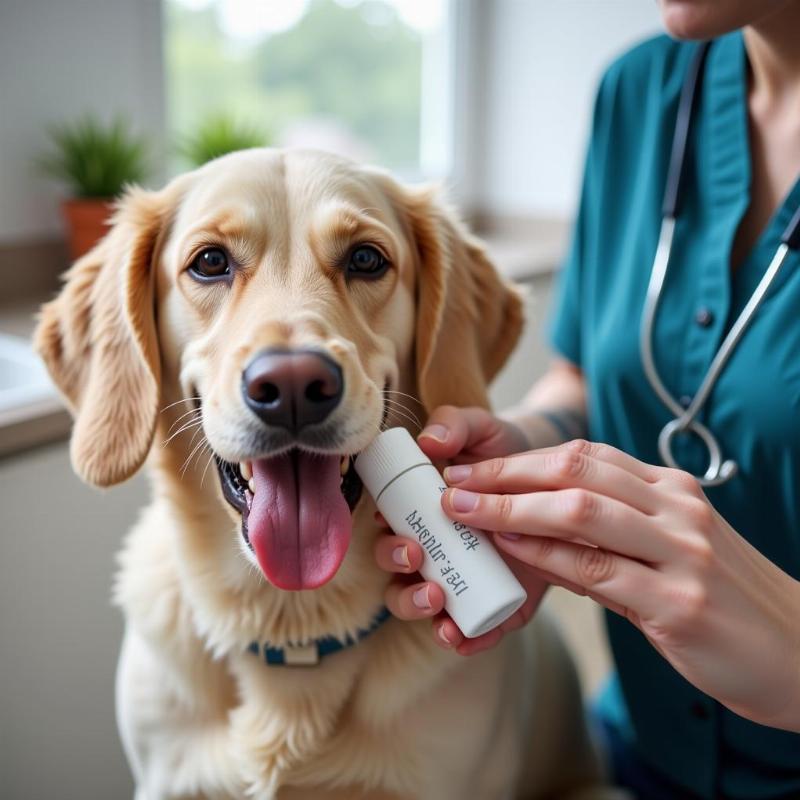Dealing with dog bad breath after tooth extraction is a common concern for pet owners. While a little odor is expected during the healing process, persistent or worsening bad breath could signal a problem. Understanding what’s normal and what’s not is crucial for ensuring your furry friend’s swift and comfortable recovery. This article will guide you through everything you need to know about managing your dog’s breath after a tooth extraction, including potential causes, home care tips, and when to seek veterinary attention.
Understanding the Healing Process After Tooth Extraction
After a tooth extraction, your dog’s mouth will undergo a natural healing process. Initially, there might be some bleeding and swelling, which can contribute to a slightly unpleasant odor. This is typically temporary and should improve within a few days. However, several factors can influence the healing time and the presence of bad breath. These include the size and location of the extracted tooth, your dog’s overall health, and their adherence to post-operative care instructions.
Common Causes of Bad Breath After Tooth Extraction
While some bad breath is expected, persistent and foul-smelling breath can be a sign of complications. Here are some common culprits:
- Infection: Bacteria can enter the empty tooth socket, leading to an infection. This can manifest as persistent bad breath, along with redness, swelling, and discharge.
- Food particles: Bits of food can get trapped in the extraction site, creating a breeding ground for bacteria and causing bad breath.
- Dry socket: This occurs when the blood clot that forms in the tooth socket dislodges prematurely, exposing the underlying bone and nerves. It can be very painful and often results in a noticeably foul odor.
- Oral diseases: Pre-existing oral health issues, such as periodontal disease, can contribute to bad breath even after the extraction.
Managing Your Dog’s Breath at Home
Proper home care is essential for promoting healing and minimizing bad breath after tooth extraction. Your veterinarian will provide specific instructions tailored to your dog’s needs. These typically include:
- Oral rinses: Your vet may prescribe an antiseptic oral rinse to help keep the extraction site clean and reduce bacteria.
- Pain medication: Managing pain is crucial for ensuring your dog eats and drinks properly, which can indirectly help with breath control.
- Soft food diet: Sticking to soft food for a week or two after the extraction can prevent further irritation and discomfort. You can find specialized dog food designed for dental recovery how to feed a dog with no teeth.
- Avoiding chewing toys: Discourage your dog from chewing on hard toys or objects until the extraction site is fully healed.
 Dog Using Antiseptic Oral Rinse
Dog Using Antiseptic Oral Rinse
When to Seek Veterinary Attention
While mild bad breath is often part of the healing process, certain signs warrant a trip back to the veterinarian:
- Persistent bad breath: If your dog’s breath doesn’t improve within a week or two after the extraction.
- Worsening breath: If the odor becomes significantly worse or changes in character.
- Increased swelling or redness: Around the extraction site.
- Discharge from the extraction site: Especially if it’s pus-filled or foul-smelling.
- Loss of appetite or lethargy: These can indicate pain or infection.
- Excessive bleeding: From the extraction site.
Conclusion
Managing dog bad breath after tooth extraction requires careful observation and diligent home care. By understanding the healing process and potential complications, you can help your furry friend recover comfortably and quickly. Remember to follow your veterinarian’s instructions closely and don’t hesitate to contact them if you have any concerns. Addressing any issues promptly is vital for ensuring your dog’s oral health and overall well-being.
FAQ
- How long does bad breath typically last after tooth extraction in dogs? Mild bad breath can last for a week or two after extraction. Persistent or worsening breath could signal a problem.
- What can I give my dog for bad breath after tooth extraction? Only use products recommended by your vet. Home remedies can be harmful.
- Is dry socket common in dogs after tooth extraction? Yes, it can occur. Contact your vet immediately if you suspect dry socket.
- Can I brush my dog’s teeth after an extraction? No, not immediately. Follow your vet’s instructions on when to resume brushing.
- What should I feed my dog after a tooth extraction? Soft food is recommended. Ask your vet about specific dietary recommendations. double k9 teeth in dogs
- How can I prevent bad breath in my dog after tooth extraction? Follow post-operative care instructions, maintain good oral hygiene, and schedule regular dental checkups. how much does it cost to pull dogs teeth
- My dog is refusing to eat after a tooth extraction, what should I do? Contact your veterinarian immediately. This could indicate pain or other complications. tooth extraction in dogs aftercare
Related Articles
Beautdogs.us is your premier resource for all things dog-related in the US. We provide expert advice on dog breeds, care, and products, catering to both new and experienced dog owners. Our comprehensive guides and articles cover everything from nutrition and training to health and wellness, empowering you to be the best pet parent possible. For personalized guidance and support, reach out to our team of experts. Email: [email protected], Phone: +1 501-555-7529. Visit Beautdogs.us today and discover a world of valuable information for your canine companion.